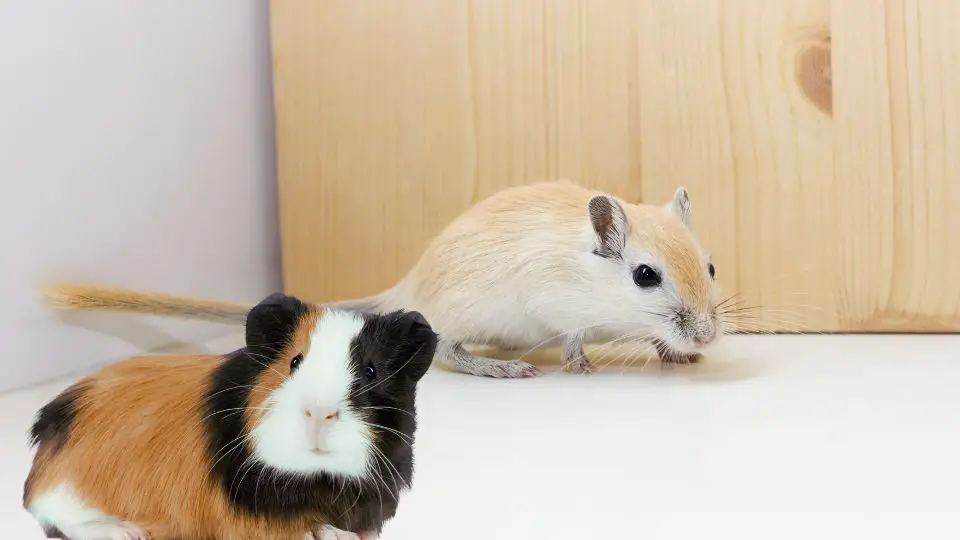Have you ever noticed your gerbil lying flat on its stomach and wondered what it means? While it may seem unusual, this behavior is not uncommon among gerbils.
A gerbil may lie flat on its stomach as a natural resting position or to feel secure and comfortable. Understanding why gerbils adopt this resting position can provide valuable insights into their behavior and well-being.
In this article, we will explore the reasons behind gerbils lying flat on their stomachs and what it signifies.
Understanding Gerbil Behavior
Gerbils, small and curious creatures, have unique behaviors that can provide insights into their well-being and emotions. As natural burrowers, they display a range of resting positions that reflect their natural instincts and comfort levels. By understanding these common resting positions and their meanings, we can gain a deeper understanding of our gerbil friends.
The Curled-Up Ball Position
Gerbils often curl up into a tight ball when they sleep or rest. This position is characterized by the gerbil tucking its head and limbs under its body, creating a compact shape. The curled-up ball position suggests that the gerbil is seeking warmth, security, and a sense of safety. It is a common position for gerbils to adopt when they are feeling relaxed and comfortable.
Lying on the Side
Gerbils may occasionally rest on their side, with their body stretched out horizontally. This position indicates a high level of relaxation and trust. When a gerbil feels completely at ease in its environment, it may choose to lie on its side as a sign of contentment and vulnerability.
Flat on the Stomach
Another resting position commonly observed in gerbils is lying flat on the stomach. In this position, the gerbil stretches out its body, lying completely flat on its belly. It signifies a sense of relaxation, comfort, and security. When a gerbil feels safe and undisturbed, it may choose to lie flat on its stomach as a way to fully unwind and enjoy its surroundings.
Nesting and Burrowing
Gerbils are known for their exceptional burrowing abilities, and creating nests is an essential part of their natural behavior. They often spend time building intricate nests using bedding materials, such as shredded paper or soft bedding. Nests serve as cozy retreats where gerbils can rest, sleep, and feel secure.
Understanding these common resting positions can provide valuable insights into the well-being and comfort of your gerbil. By observing their behavior and paying attention to their body language, you can better cater to their needs and create an environment that promotes their overall health and happiness.
Is It Normal For Gerbils to Lie Flat?
It is not considered normal for gerbils to frequently lie flat on the ground, as they are generally active and alert creatures. However, if you notice your gerbil occasionally lying flat on its stomach, it is not necessarily a cause for alarm. It’s important to observe their behavior and consider potential factors that may contribute to this behavior.
Personal Preference
Just like humans have their own sleeping positions, gerbils have their preferences too. Some gerbils may simply enjoy lying flat on their stomachs as a comfortable resting position. It may be their preferred way of relaxing or taking a break from their usual activities. If your gerbil is healthy and exhibits normal behavior otherwise, there is no need to worry.
Temperature Regulation
Gerbils are sensitive to temperature changes, and lying flat on their stomachs can help them regulate their body temperature. They may choose to lie on a cooler surface, such as the floor of their habitat or a ceramic tile, to cool down.
On the other hand, they may lie on a warmer surface, such as a cozy bedding area, to stay warm in cooler environments. Temperature preferences may vary among gerbils, so it’s essential to provide a suitable environment with proper temperature regulation options.
Health Concerns
In some cases, a gerbil lying flat on its stomach can be a sign of underlying health issues. It could indicate discomfort or pain. If your gerbil’s behavior changes suddenly, such as a significant increase in the frequency of lying flat or accompanying signs of illness like weight loss, loss of appetite, or lethargy, it’s crucial to consult a veterinarian for a thorough examination and appropriate diagnosis.
To provide the best care for your gerbil, ensure their habitat is properly set up with an optimal temperature range (around 65-75°F or 18-24°C) and suitable bedding materials that promote their comfort. Regularly monitor your gerbil’s behavior and overall health to detect any changes or signs of illness promptly.
Observing a Gerbil Lying Flat on its Stomach
When a gerbil lies flat on its stomach, it typically stretches out its body, with its legs and tail extended along the ground. The gerbil’s head may rest on the substrate or be slightly elevated. This position may be maintained for a short period or for more extended periods of relaxation.
In many cases, a gerbil lying flat on its stomach is a sign of relaxation and contentment. It indicates that the gerbil feels safe and secure in its environment. Gerbils are naturally curious animals, and after exploring or engaging in playful activities, they may choose to lie flat as a way to unwind and recharge. It can be seen as a reflection of their overall well-being and a sign that they are comfortable and at ease.
When to Be Concerned
While a gerbil lying flat on its stomach is often a normal and benign behavior, there are certain instances when it may indicate an underlying issue that requires attention. If you observe any of the following signs along with the behavior, it is advisable to monitor your gerbil closely and consider consulting a veterinarian:
- Changes in Eating or Drinking Habits: If the gerbil’s appetite or water consumption significantly decreases or ceases altogether, it may indicate an underlying health issue.
- Weight Loss or Lethargy: Rapid weight loss or a noticeable decrease in energy levels may be indicative of an underlying problem that requires veterinary attention.
- Signs of Pain or Discomfort: If the gerbil appears to be in distress, exhibits abnormal postures, or reacts negatively to touch or movement, it could indicate a health concern.
Conclusion
In conclusion, observing a gerbil lying flat on its stomach is a natural behavior that can indicate relaxation and contentment. Gerbils often assume this position to rest and unwind after periods of exploration and play. However, it’s crucial to be attentive and monitor your gerbil’s overall health and behavior.
If you notice any concerning signs, such as changes in eating habits, weight loss, or signs of pain or discomfort, it’s recommended to consult a veterinarian for further evaluation. By understanding and interpreting your gerbil’s behavior, you can ensure their well-being and provide a nurturing environment for their happiness.







